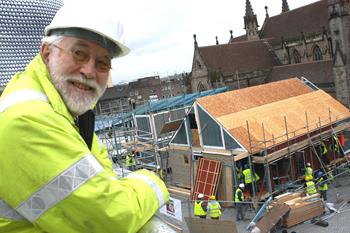Build to Rent is Blossoming – RIBA Products in Practice
New Private Rented Sector With their focus on innovation, design, sustainability and tenant satisfaction, todays institutional led ‘Build to Rent’ sector is creating a new image as well as new living environments. Embryonic Darling With 8,000 completed and 30,000 in the pipeline, the attention of developers, investors, media and government has been well and truly ‘grabbed’. Demand for homes is soaring - Savills forecast that another 1.2 million more private rented homes will be needed by 2020. £10 Billion UK Institutional Commitment Buy to let investors are being replaced by build to rent operators. Institution-led, private rental models are purpose-built, managed by professional operators. Early schemes by Essential Living, Fizzy Living and Grainger, have been joined by blue chips like Legal & General (L&G) with a £600 million fund, while Funding Britain’s rental revolution a report by Addleshaw Goddard and the British Property Federation states that UK institutions have now committed more than £10 billion to the sector. Brand Differentiation New, “build to rent” clients are eager to differentiate themselves from the old private rented sector, defining their brands through their buildings as well as their service. Although some buy from developers, their business model is very different from the housebuilding industry, with products focused on innovation, design, and sustainability. The science of design According to Russell Pedley of architect Assael, their business model is very different "What’s changing for us from a design point of view is the client focus, which is on net operating income rather than capital value. That brings a longer term perspective to every aspect of a development, from materials specification to place-making, and changes the economics of sustainability and life cycle analysis.” Design Matters The Urban Land Institute’s “Build to rent: A best practice guide” thinks it is becoming commonplace for build to rent players to research and interrogate the composition of their schemes. In Pedley’s view, such an intense focus does not create a restrictive working environment for architects, ‘For us it’s more rewarding to be focusing on the product and the place, and to be working for the operator. We’ve found it motivating.’ New Models of Living Steve Sanham of mid-market developer Hub – who have 1,200 units in the London pipeline – says, ‘We are not looking for standard solutions. We want to work collaboratively with our architects.’ Their mix of market sale and private rental homes include triplex apartments with a bedroom on each floor, an innovation designed to appeal to three flat-sharers. Essential Living’s designs aim to be family friendly, incorporating a creche and play space, with apartments that feature corner living spaces, oversized balconies and nurseries designed to minimise noise disturbance. ‘The design was very much driven by focus groups organised by the clients,’ explains Rory O’Hagan, director of Assael, the project architect. One ingredient influenced by those focus groups is the balconies, which will be clad in perforated sheet to prevent children from losing or throwing away toys or other objects. Affordable housing provider Peabody, sees private rental as part of overall regeneration, understanding the local market, what is already there, and the market’s ability to absorb new units, as well as at the local amenities. Fizzy works to keep rents affordable because build to rent success depends on keeping customers happy and in their homes. Home or hotel? The new Build to Rent players are comparing their homes not with housebuilder offerings, but to hotels, with star rated services, welcoming receptions and host of amenities. ‘By designing buildings to be rented as a whole where a customer’s home begins at the door of the building – not the flat – we can make renting an aspirational choice rather than housing of last resort,’ says Essential Living’s spokesman Andrew Teacher. US Style Multi-Family Housing These US build to rent developments are being equipped with amenities such as climbing walls, pet grooming areas and office space. Dominic Martin of Westrock explains: ‘In the US, agents describe an amenities arms race, to highlight the competition over the amenities being provided. Yet a misconception has grown up around this; in fact, the critical element in US rental developments has always been service. A private rented building can be considered like a long-stay hotel – it’s the operational aspect that is key. We’ve recognised that; it’s why we’ve recently appointed LIV as our property manager.’ Westrock’s UK Office to Home Conversions In the UK Westrock has five Private Rental Schemes, all office to residential conversions outside London, the first in Exeter. They boast features like a gym, keyless access and a residents’ lounge. Provision of amenities comes down to simple business economics, says Martin. ‘What you put into a development depends on the size/quantum of units of the scheme – generally, the bigger the development, the more you can put into it, because there are more residents to share the fixed running costs. For instance, the Pan Peninsula scheme, in Canary Wharf, has a gym, pool, 24-hour concierge and rooftop bar, but that’s because it’s a large development. That often gets forgotten when people compare US rental developments to UK ones – UK schemes are generally smaller, at the moment, in scale.’ Bob’s Your Manager Fizzy Living – backed by affordable housing provider Thames Valley Housing and a sovereign wealth fund – has a manager – always known as Bob – on hand in every building. They also have space where tenants can socialise both face-to-face and via Facebook. ‘Our flats are well located and our customers are generally in their early 30s so they don’t need an on-site pool or have the money for luxuries,’ says Harry Downes, Fizzy Living’s managing director. They have 250 units in occupation and around 1,000 more under contract. Their affordable rents average 20% - 30% of income. In their view build to rent success ultimately depends on keeping customers happy and in their homes. ‘If a tenant doesn’t like what we’re doing they’ll pack their bags and leave,’ Downes says. Keeping Customers Happy Hub offers community function rooms and rooftop allotments. Essential Living adds a communal roof garden ‘So even if you’re renting a smaller apartment, you still get to enjoy the view and host parties for groups of friends,’ The business rationale of build to rent rules out sumptuous penthouse roof terraces for the lucky few, says Kitson Keen of Peabody. ‘It’s a matter of dribbling the benefit through to all residents and is a really good way of adding value for the customer. You don’t hog the benefit for one person; instead you share it out for everyone to enjoy.’ Doing More Differently – and using Off-site MMC The sector could prompt further innovation, notably with its interest in offsite manufacture of housing. Build to rent developers gain no commercial benefit from phased delivery of schemes, and so they aim to get developments built and let quickly. L&G is establishing a 550,000ft2 factory near Leeds (due to be up and running in June) that will be producing cross-laminated timber modules for housing. Assael Architecture is looking at prototyping in cross-laminated timber at its two L&G projects in London, at Walthamstow and Hackney. Read Full Article Technical Expertise Whatever your business model or design, the chances are that it will need some degree of technical expertise for it to be buildable. Conceptual designs, especially if produced to overcome some local planning objection, or meet new ‘build to rent’ criteria are likely to be more ‘buildable’, Building Regulation compliant, and cost effective if the technical structural aspects have been addressed as the design is worked up. Ideally a ‘team working’ approach is desirable and can have significant benefits, especially in the area of energy efficiency.Visit the Benfield ATT Group website for more information on Build to Rent is Blossoming – RIBA Products in Practice





